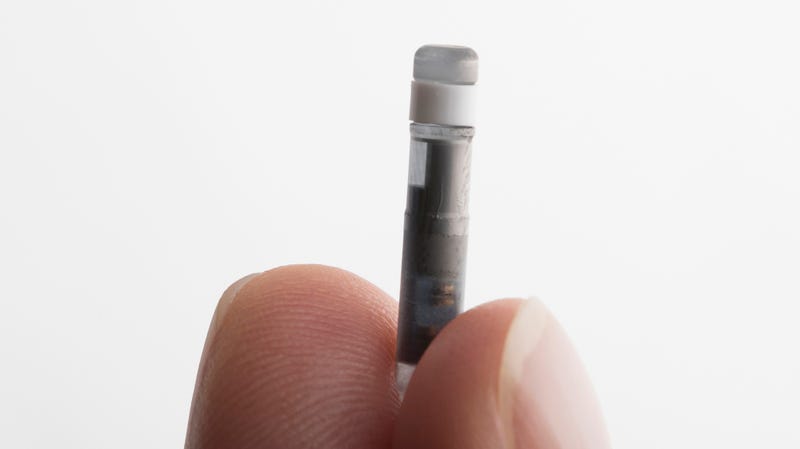 Eversense’s implantable sensor, seen above.Photo: Eversense
Eversense’s implantable sensor, seen above.Photo: Eversense
Keeping track of your blood sugar is poised to become a lot easier for some diabetics living in the U.S. On Thursday, the Food and Drug Administration approved the Eversense Continuous Glucose Monitoring (CGM) system. The Eversense is not the first approved CGM system, though it is the first with a fully implantable sensor, according to the agency. It’s also the longest-lasting by far, being able to be used for 90 days at a time, compared to previous systems that need to be replaced every seven to 14 days.
The Eversense uses a small pill-shaped sensor that’s implanted under the skin by a doctor in a five-minute procedure. The sensor is coated in a fluorescent chemical that responds to glucose, allowing the sensor to measure someone’s glucose levels in real time. A wireless, rechargable transmitter affixed to the skin on top of the implant through an adhesive both powers the implant and allows it to send signals to a mobile app. Every five minutes, it sends measurements to the app, which will alert users if their blood sugar is too low (hypoglycemia) or too high (hyperglycemia). The sensor also has vibration alarms that can go off in case someone’s mobile device is out of range.
“The FDA is committed to advancing novel products that leverage digital technology to improve patient care,” said FDA Commissioner Scott Gottlieb, in a statement announcing the approval. “These technologies allow patients to gain better control over their health. This approval of a more seamless digital system that gives patients the ability to effectively manage a chronic disease like diabetes is a vivid illustration of the potential for these mobile platforms.”
The Eversense was approved following an unanimous 8-0 vote of recommendation by an advisory panel convened by the FDA this March. It found that the device was safe, effective and comparable in accuracy to other glucose monitors. Based on clinical trial data of 125 people, both with type 1 and 2 diabetes, the device caused adverse effects in less than one percent of the volunteers. The device’s safety record will continue to be tested through a post-market study, though.
The first CGM systems were approved by the FDA starting in 1999, which could be worn for three days in a row. The newest versions, prior to the Eversense, now last as long as two weeks at a time. Because CGMs can be difficult to calibrate correctly in the first few days, it’s hoped the 90-day limit of the Eversense will allow for more general accuracy, since it only needs to be replaced four times a year.
That said, there are some drawbacks to the Eversense that other CGMs don’t have. Most current devices don’t need to be attached by a doctor. And some newer devices also no longer require a finger prick test to calibrate its reading, while the Eversense still needs two a day taken 10 to 14 hours apart. The Eversense also isn’t approved to work with insulin pump devices—a so-called closed loop system that would function as an artificial pancreas, providing the right amount of insulin every moment of the day.
To date, the FDA has only approved one such device, the MiniMed 670G hybrid closed-loop system, for people with type 1 diabetes. The same day as the Eversense approval, the FDA also cleared the use of MiniMed 670G for children between the ages of 7 to 14. The original approval, made in 2016, cleared it for type 1 diabetics over 14.
Eversense’s limits don’t necessarily stop at 90 days. The European Union, which approved the device in 2016, recently approved a 180-day version last October. It’s expected the U.S. version will launch later this summer.
[FDA]